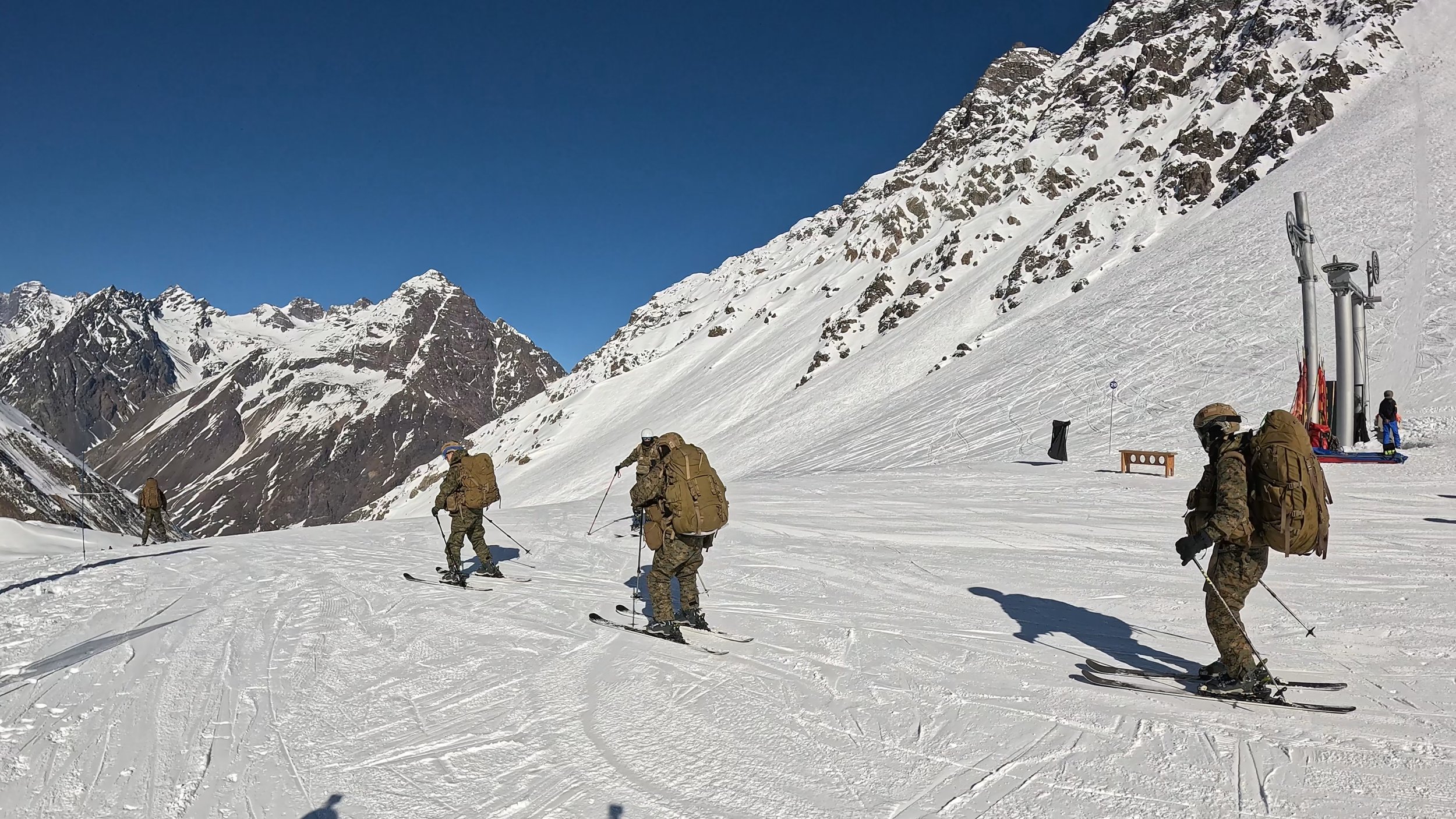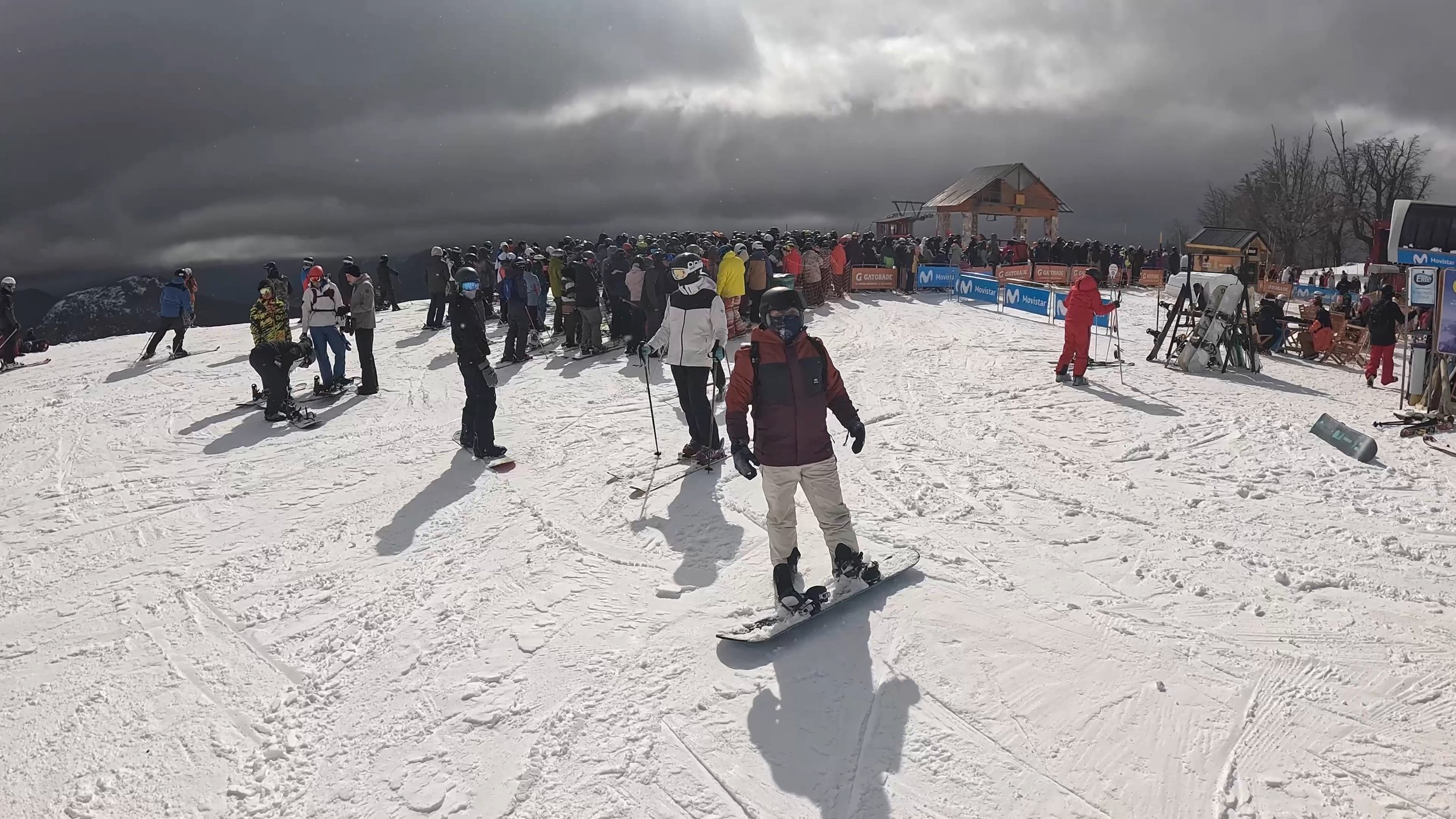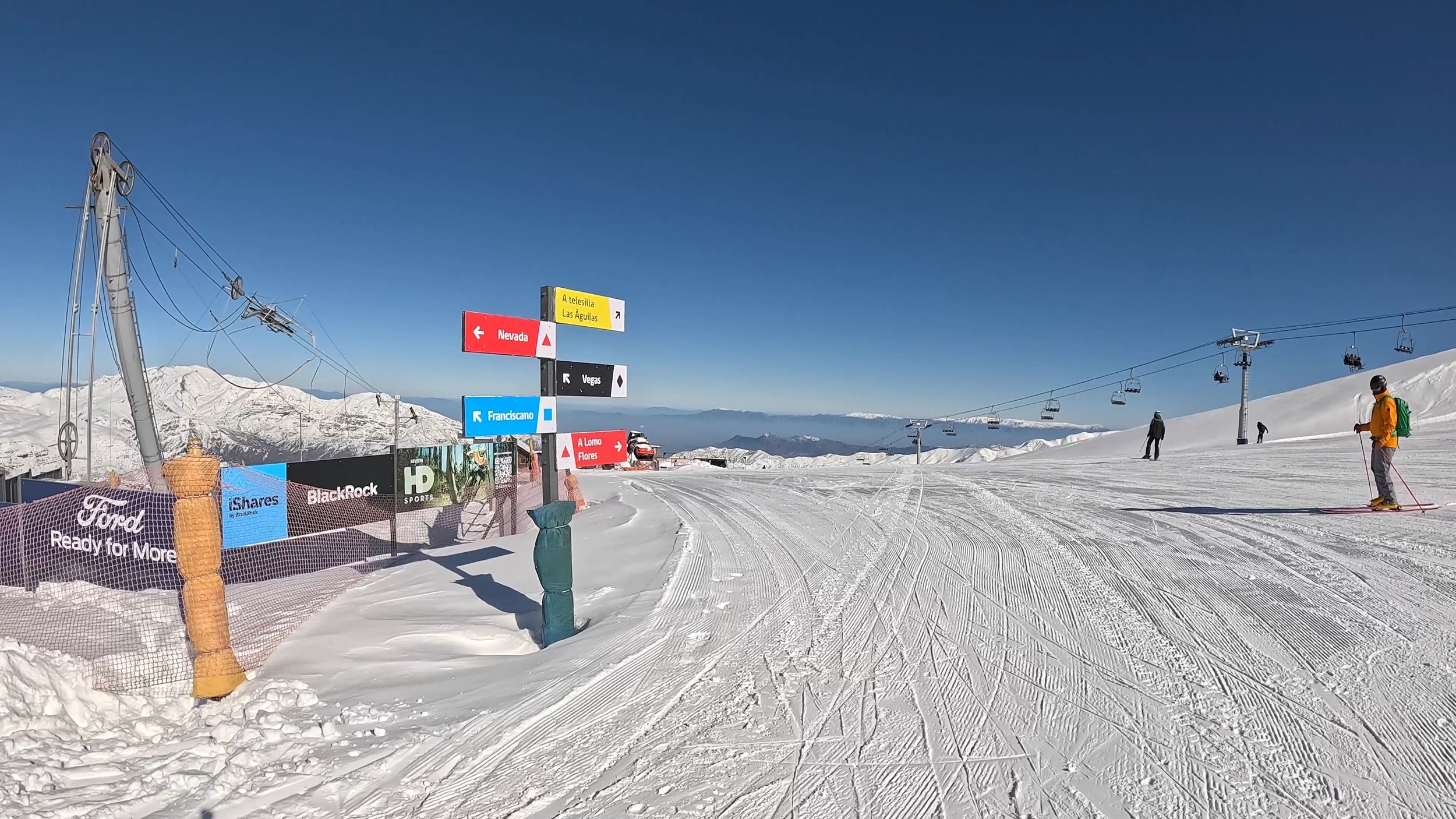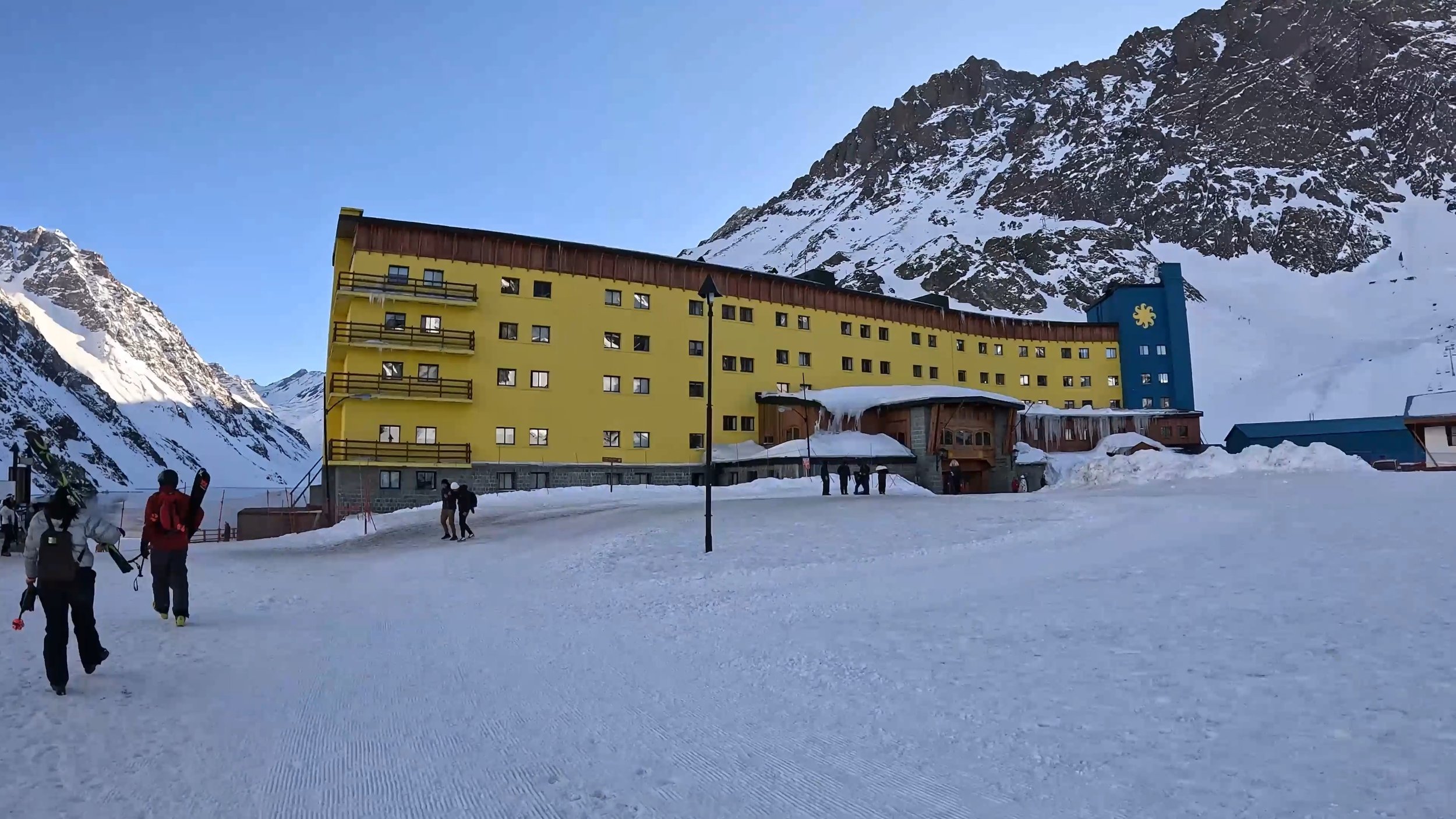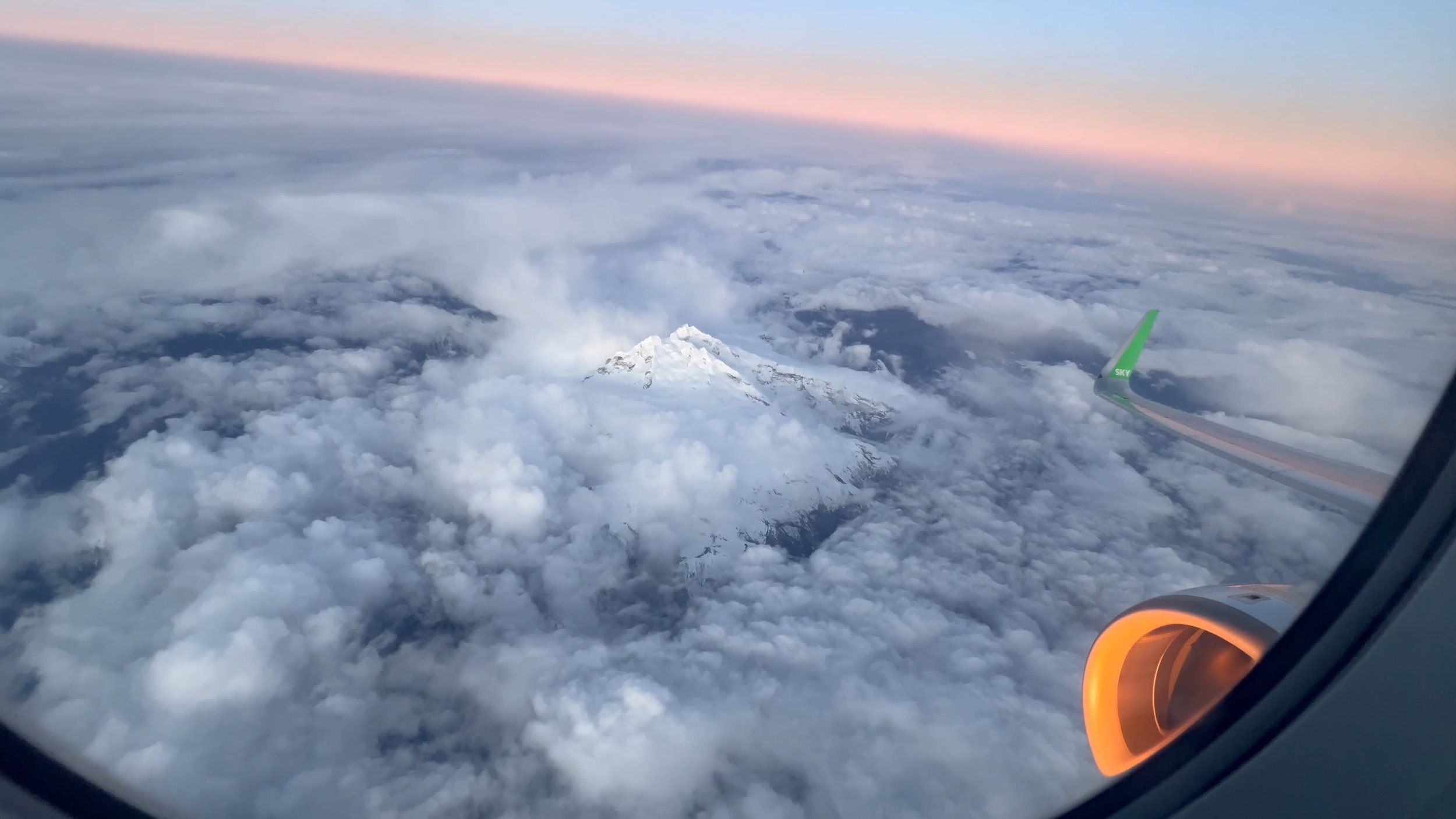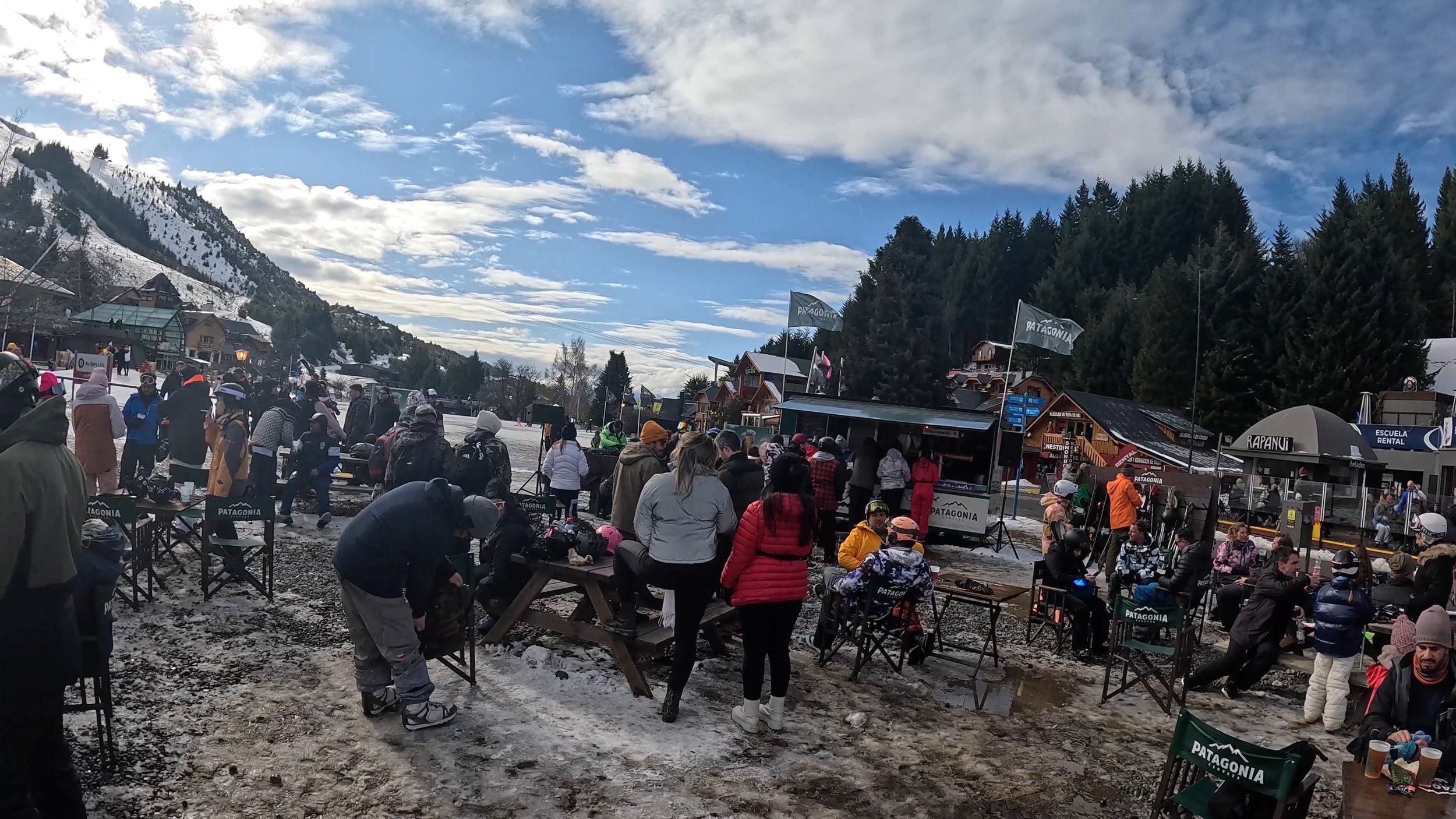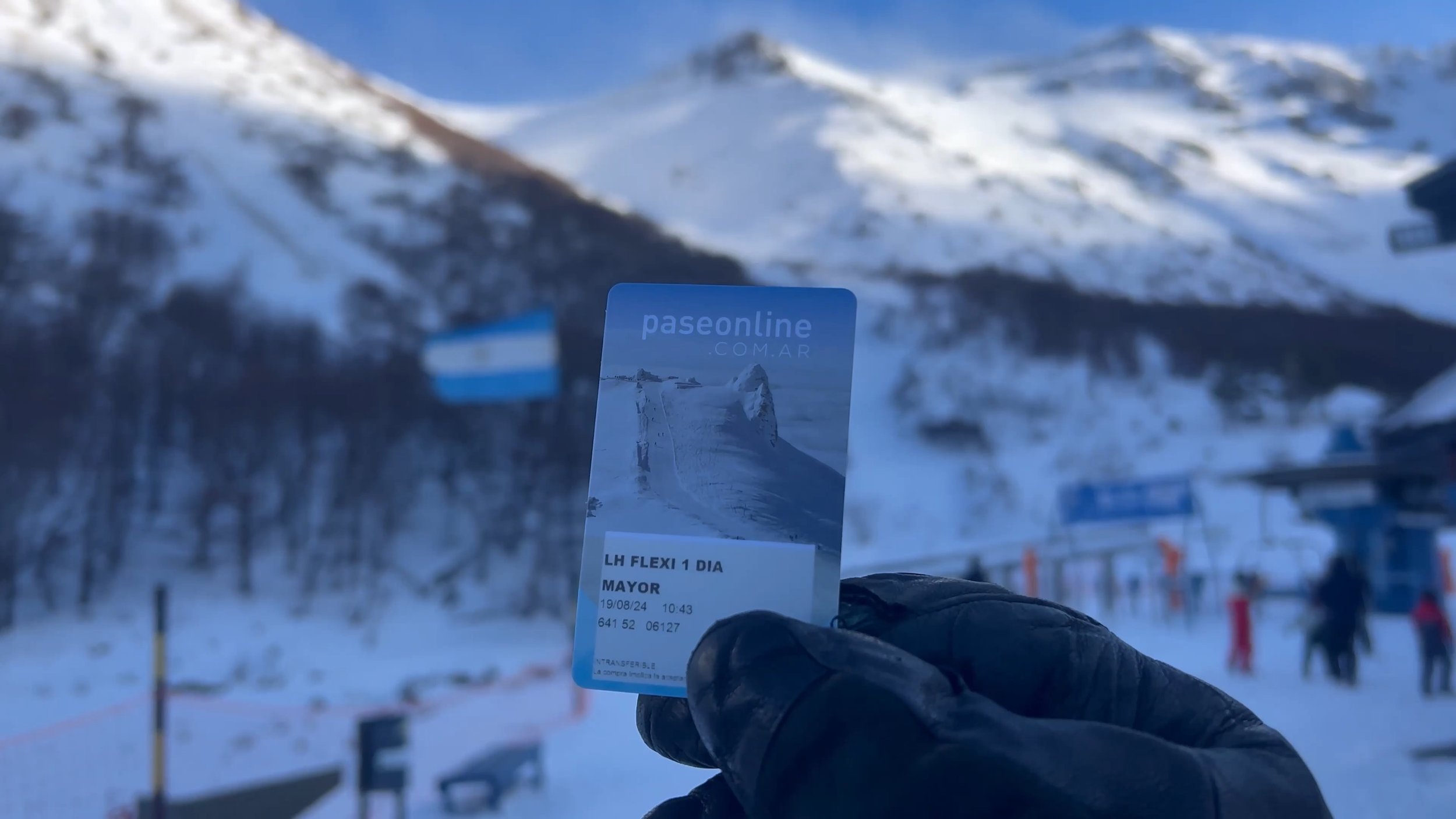The Most Shocking Things About Skiing in South America (Vs. the USA)
When it comes to skiing and riding in the Northern Hemisphere, it seems like the sphere of winter sports shuts down for good once April and May roll around. But it turns out that as the snow is melting on the mountains of North America, a new world is in the process of blossoming down south—and we’re talking really south. The South American ski resorts of Chile and Argentina offer an incredible chance to hit the slopes during the warmest months of the Northern Hemisphere, but it turns out there are a lot more distinguishers to a South American ski vacation than just the time of year the resorts operate.
So what should you expect in South America versus a ski vacation up north? Well, our team just had the privilege of spending three weeks checking out the destination ski areas of Chile and Argentina, and in this article, we’ll go through the major differences of skiing and riding between the two hemispheres.
The ten Chilean and Argentinian ski regions our team visited in recent weeks.
Mountain Aesthetic
High-Alpine Bias
The first thing that stands out about South America’s ski resorts is just how different they look. Unlike in North America, where below-treeline terrain is essentially the default trail type, South American skiing is much more high-alpine biased. In fact, many ski resorts are entirely above-treeline, with no trees on premise at all. A few mountains do have some tree-defined trails, although especially north of the Patagonia region, these are the exception, rather than the norm. But the resorts that do have below-treeline areas feel pretty distinct compared to your typical North American mountain, with unique tree species bringing traits such as large moss growths, unusual colors, and peculiar shapes that make for an exotic feel. Also notable is that these below-treeline resort areas are often somewhat rolling and meadow-like, which is almost hard to believe when compared to the jagged above-treeline zones that often exist just a few hundred feet above within the same mountains. If you’re from the Northern Hemisphere, it might feel like someone copied and pasted the high-alpine slopes from out west onto a Northeast ski resort.
Peak Views
South America’s wide-open slopes lend themselves to the region’s next major strength: its incredible peak views. Unlike in North America, where ski resorts span a variety of mountain ranges, all of South America’s resorts sit along just one range: the Andes Mountains. The tallest resorts in the Chilean and Argentinian Andes top out around the same height as those in the U.S. Rocky Mountains, but unlike in the Rockies, these South American resorts are far from the tallest reaches of the region. In other words, there are peaks visible from within South America’s ski areas that tower several thousand feet higher than the top of their skiable boundaries. It’s not uncommon for peaks of 15,000-17,000 feet (4,600-5,200 m) to be visible from a South American ski area, which puts the region in stark contrast to the contiguous United States and Canada, where not a single peak this high exists. In other words, while you might feel like you’re on top of the world when you reach the summit of a North American ski area, there’s still quite a bit of elevation gain to get there when you hit the top of a South American resort.
Many South American ski areas are surrounded by peaks that extend thousands of feet up from the tops of the resorts. The extremely high altitude precludes development up there.
This might beg the question: why don’t the South Americans just build their resorts up to the tops of these incredibly high mountain peaks, taking advantage of the snowy conditions up there? Well, once you get above about 13,000 feet (3,960 m) in elevation, it becomes a lot tougher to breathe, even for those in great aerobic shape, making the operation of a general public ski resort past that point near impossible. With only a few exceptions, North American ski resorts have been lucky enough not to worry about building too high when developing their peaks, whereas with South America, this is a very real concern.
South America’s mountain ranges don’t just stand out for their raw height—they’re also quite impressive for their stunning natural beauty. The Andes are much more rugged and prominent than even the Rockies, Sierra Nevadas, and other ranges in North America, making for distinctive, jaw-dropping mountain faces visible from the resort boundaries. On cold days, ice crystals can form over trees and in-bounds rock formations, which adds to their distinctiveness. And some resorts, especially in the southern Andes of Patagonia, overlook massive lakes that feel like they’re out of a completely different climate system. Combined with the wide-open slopes of the resorts here, it’s rare to find a place where the views don’t impress.
Some South American ski resorts offer views into valleys as far as 10,000 feet (3,050 m) below the slopes.
Valley Views
It’s also worth noting that while South America’s ski resorts don’t extend up the full height of the Andes Mountains, their prominence results in some serious elevation gain in very quick succession. This means that in the case of certain resorts, especially those near Santiago, guests can see down into valleys that are as far as 10,000 feet (3,050 m) below where they are on the mountain. The city of Santiago is directly visible from the slopes of Valle Nevado, La Parva, and El Colorado when it’s clear out (which is by no means always a given), making for what might be the highest-elevation natural viewing points of any city in the Americas.
Volcanoes
South America’s resorts aren’t just unique in how tall their surrounding peaks are—they also stand out for how many of them are on or directly adjacent to volcanoes. While those who usually hit the slopes in North America probably won’t have experience with this type of terrain unless they’re from the Pacific Northwest, a sizable chunk of resorts in South America, especially those south of Santiago, sit on or near genuinely active volcanoes that can spew fumes while the ski resort is open. In fact, some mountains have permanently closed resort areas due to ongoing geological activity.
Quite a few South American ski resorts are located on or immediately adjacent to active volcanoes.
Resort Size
So South America’s ski resorts sit in a completely different topographical environment than those in the Northern Hemisphere. But how are the physical resorts themselves designed? Well, the first thing you might notice is that in general, South American destination ski areas are a bit smaller than the top mountains in the United States and Canada. That’s not to say these resorts are small—many of them still have days worth of terrain to explore—but the biggest mountains are closer in size to the resorts of Vermont, rather than the behemoths of Colorado or British Columbia. The Tres Valles resorts of Valle Nevado, El Colorado, and La Parva do have trail connections and would be competitive size-wise with the best North American resorts if they were one combined area, but as of right now, there’s no singular lift ticket product that gives access to all three of them (although as of this recording, the Power Pass season pass product does give access to both Valle Nevado and La Parva).
Most South American ski resorts are much smaller than many of the larger destination resorts of North America.
Lift Infrastructure
In addition, South American ski resorts just do not have the same lift infrastructure as the resorts in the U.S. and Canada. Only four ski areas on the continent—Valle Nevado in Chile and Cerro Catedral, Cerro Bayo, and Chapelco in Argentina—have high-speed lifts of any kind. In general, South America’s major ski resorts are held down by slow, fixed-grip chairlifts, many of which are lower capacity than they should be or several decades old at this point. Even the few high-speed chairlifts and gondolas are showing their age.
But in Chile especially, even slow chairlifts might be considered a luxury. Several resorts require the use of surface lifts to get to certain resort zones, especially in upper-mountain areas. And unlike in North America, where surface lift rides are typically short, smooth, and reasonably mellow, none of these facets necessarily hold true on the reverse side of the globe. The gradients for South America’s buttons and t-bars can get extremely steep, requiring substantial energy just to hold on, and when loading, these lifts can have a not-insignificant kick to them, jolting you into the air as you hold on for dear life. At certain resorts, it can take multiple surface lift rides to get back to the nearest chairlift.
If you are not comfortable with riding surface lifts, we highly recommend sticking to the Patagonia region of Argentina for your South American ski trip—or perhaps holding off on a trip to the continent until you’re more comfortable. Also worth noting—South American ski resorts can have a ton of randomly closed lifts on off-peak weekdays, and at some of the less internationally-oriented mountains, trail and lift status information is not readily available, whether within the resort itself or online.
But even besides the abundance of button lifts and t-bars, some of South America’s lifts are just plain crazy. Chile’s Portillo ski resort might have the most extreme uphill transportation contraptions we’ve ever seen, with one-of-a-kind slingshot surface lifts that pull three-to-five people up a not-so-mellow slope all at once with no defined unloading area and a need to dismount backwards. The continent is also home to a number of lifts that are just plain weird, including gondolas that have to be manually pushed around their terminals or have seats that face away from each other, chairlifts with chairs of mixed capacities, or cable cars that are banned from use by skier traffic and reserved for sightseers only. In addition, South America’s chairlifts just have much wilder tower spans than one might find in North America, with huge vertical stretches over cliffs, streams, roads, or other features that would normally only happen in a gondola or tram in the U.S. or Canada.
Many South American ski resorts feature an abundance of t-bar and button surface lifts, some of which can be quite steep.
On-Mountain Facilities
But one place where South America stays reasonably competitive with the Northern Hemisphere is in its on-mountain facilities. Most of the resorts in Chile and Argentina—even those with absolutely ancient lift infrastructure—offer a number of places to stop in for a break throughout the resort footprint. Many of the setups are reminiscent of Europe, with relaxed, full-service restaurants or made-to-order food, meaning that it’s tough to find quick grab-and-go meals. In addition, while food may not be hard to find on the mountain, it can be extremely expensive, even by North American standards. That being said, there are some pretty cool, decidedly-region-specific food items you can get depending on the mountain—although at the more internationally-oriented resorts, on-mountain lunch options do tend to be less unique and more cafeteria-like.
Most South American ski resorts offer several on-mountain places to rest and grab some food, though they can be very expensive.
Resort Clientele
Typical Ability Level
The restaurant and lift setups are far from the only cultural differences guests will notice at South American ski resorts. A surprisingly big difference is in the skiing and riding styles of resort clientele. Especially in Chile, the resorts attract a lot of international tourists from other parts of South America, most notably Brazil. These tourists are much more of the once-a-year vacation crowd than local alpine enthusiasts, so resorts tend to attract more of a beginner-oriented and less-situationally-aware crowd compared to North American resorts.
Crowd Flow
This circumstance has some consequences for the flow of skier and rider traffic at a typical South American resort. People are less aware of their surroundings on the slopes and will step on your equipment while in line if you’re not careful. The overwhelming majority of guests stick to groomers the whole time, and of the visitors who ski, their ski widths tend to be on the narrower side. This may not seem like a big deal at a first glance, but at the few resorts that have gondolas, the ski holders may not be able to hold skis of even average width by North American standards. On the plus side, this situation does often mean that harder trails at South American ski resorts take longer to get tracked out than at those on the opposite side of the globe.
Due to the mountainous terrain along their borders, Chile and Argentina teach their armies how to ski at select South American resorts.
Army Presence
There are a few other decidedly surprising types of people you might see at the ski resorts in Chile and Argentina. Depending on which mountain you visit, you might run into national army regiments dispersed around the resort. But these soldiers aren’t usually patrolling anything; instead, they’re there to get lessons on how to actually learn how to ski in the first place! Chile and Argentina’s borders are quite mountainous and snowy, making knowing how to effectively ski a vital skill for their militaries. When you see these soldiers, you’ll often see them alongside an instructor who’s teaching them how to confidently get down the slopes.
Pedestrian Tourist Presence
In addition, many South American resorts attract tourists who don’t even ski or ride at all. Many people who visit this part of the Andes have never seen snow at all, and they’re just there to sightsee, play in the snow, and go sledding. These on-foot tourists are mainly from Brazil, and they’re typically distinguished by designer outfits and fancy sunglasses. It’s a crazy phenomenon to see swarms of tourist buses pull up in parking lots, massive crowds surrounding popular photo spots, and insane lift lines of pedestrians waiting to download chairlifts. Sometimes, resorts will slow down the speeds of their lifts to allow pedestrians to get on.
South American ski resorts attract tons of pedestrian tourists from warm-weather countries like Brazil. Seeing them download chairlifts is a common occurrence.
Busy Season
The typical South American clientele also means that the resorts of Chile and Argentina, just like those of North America, have their busy seasons too. If you want to avoid the bulk of the crowds, don’t visit South America in July—this is when all the Brazilians come due to their winter holiday school break, which generally lasts the entire month. In August, resort traffic tends to become a lot lighter, although at the most popular resorts, things can stay relatively busy through the first few weeks of that month too. It’s worth noting that while long lift lines are a thing to consider at South American ski resorts, congestion on the physical slopes is a much more present issue than at most of the mountains in the United States and Canada. In South America, individual lifts don’t tend to serve the same number of runs as a typical North American resort, which results in skiers and riders funneling onto the same slopes and having a harder time spreading out. Given the typical clientele, this phenomenon is especially pronounced on beginner and intermediate trails. On the busiest days, it’s important to be extra careful not to run into other guests!
Language Barrier
Another important thing to note about skiing or riding in South America is that you’re probably not going to be able to strike up a conversation with the random stranger next to you on your chairlift ride if you speak to them in English. Both Argentina and Chile are Spanish-speaking countries, and as such, the majority of ski resort clientele speak it as their native tongue. You’ll also probably hear a good amount of Portuguese from Brazilian visitors. At the more destination-oriented mountains like Portillo, Valle Nevado, and Cerro Catedral, you can probably get away with just speaking English, but if you venture to a more locally-oriented mountain like La Hoya or Nevados de Chillán, a base level of Spanish is probably needed.
South America's ski resorts can get quite busy, especially in July.
Ease of Navigation
Trail Ratings
When it comes to communication, it’s not just speaking to others that’s distinct at a South American ski resort. The trail rating system here is a little bit different than in the U.S. and Canada. In addition to the expected green, blue, and black trail ratings, resorts in South America utilize a red rating to signify runs that straddle the blue and black ratings in terms of difficulty. Some resorts use red as an advanced-intermediate rating in between the blue intermediate and black advanced ratings, while others use red in place of a traditional single-black designation, with the black color reserved for runs that are designated as experts-only. Argentinian resorts tend to only use colors for their runs without specific shapes associated with them, while the resorts in Chile often use similar symbols to mountains in the States and Canada, including a green circle, blue square, and black diamond. In Chile, red-rated trails utilize a variety of shapes, and we saw symbols ranging from triangles to diamonds to squares. In at least one case, red-rated runs are actually signified by a black-colored diamond, although the signs on the mountain for these runs are outlined in red.
In addition to the difficulty ratings themselves, the way that trails are defined is a bit different in South America as well. If you’re familiar with skiing or riding in Europe, you’ll be quite familiar with how maintained ski runs work in Chile and Argentina. At most resorts, only the marked trails are officially part of the resort, with anything that’s outside the bounds of formal runs not patrolled or mitigated for avalanches. Resorts typically use poles to designate the edges of a trail, with many—but not all—mountains coloring these poles based on the difficulty level of each run. Some resorts also have number markings along the runs to designate how close to the bottom of the run guests are. However, unlike Europe, not every South American resort religiously grooms their official trails, often leaving some of the harder red and black runs in their natural form to mogul up. This keeps many—but not all—of the resorts in the region in good shape for those who like bumps.
Unlike in North America, Chilean and Argentinian ski resorts use a "red" rating to distinguish trails that straddle between blue and black in difficulty.
Out-of-Bounds and Backcountry Terrain Policies
When it comes to South America’s out-of-bounds terrain zones, policies vary by mountain. Some resorts designate certain areas that aren’t part of an official trail as supervised freeride zones, while at others, all the off-piste is treated as true backcountry. But either way, venturing off of a defined ski run in South America involves more risk than it would in the United States or Canada, where everything that’s not closed off by ski patrol is monitored and maintained for safety. Under certain snow conditions, avalanches are a risk within the off-piste of every South American ski resort, so if you plan to venture off an official trail, it’s crucial to check avalanche forecasts, go with a partner, and carry essential safety gear like a beacon and shovel. If you’re not familiar with this type of terrain, it might be worth hiring a guide as well.
Also, any closed trail at a South American ski resort is treated as backcountry terrain as well. The continent’s resorts may close their ski runs due to a lack of cover, unsafe slope conditions, or both. If you do decide to venture down a closed trail in Argentina or Chile, the resort staff won’t stop you—but you could find yourself facing high-risk avalanche conditions, a mandatory hikeout to get back to an operating lift, or a trail that loses its snow cover halfway down.
While they're not universally difficult to get around, some South American ski resorts have allowed their trail markings to deteriorate past the point of usability.
Resort Signage
It’s also worth noting that signage at South American ski resorts can be hit or miss. While markings on the mountain can be great at some resorts, it’s also severely neglected at others, with insufficient, outdated, or unmaintained trail maps, signage, and information boards common throughout the region. Also, not every resort has easily-understandable markings for English speakers. We highly recommend getting a hold of a trail map if you can, but some resorts don’t offer physical trail maps or even downloadable PDFs of them. In some cases, you just have to accept that it’s going to take a day or two to get used to the mountain without getting lost.
Low-Visibility Conditions
Another issue with South America’s ski areas comes in low-visibility conditions. Since the resorts are so biased towards high-alpine slopes, storms, fog, or low-lying clouds can make it really difficult to see even a few feet in front of you and get a sense of your surroundings. These circumstances make for scary conditions, especially if you’re not familiar with the resort you’re at. While the boundary sticks that designate trail edges do help a lot in these situations, these sticks do not have any design differences between their left and right sides, making it such that it can be tough to know whether you’re actually inside the trail or just outside the boundary. On the plus side, these low visibility conditions really thin out the crowds, so days like these are pretty sure fire to get quick laps—even if you can’t really see anything.
Snow conditions can be hit or miss at South American ski resorts.
Snow Quality and Resiliency
So all this talk about high-risk conditions and closed trails brings us to what might be the biggest question on a prospective traveler’s mind: how’s the snow in South America? Well on the whole, we’d say the conditions are hit or miss.
Inconsistent Precipitation
The resorts can see some surprisingly enjoyable conditions during good seasons, but especially at the resorts further north on the continent, days-long or even weeks-long snow droughts are not out of the question, which can deplete the bulk of the natural snow base and make the slopes unskiable besides snowmaking trails—which, to give the resorts some credit, there are generally a decent number of. During bad seasons, it’s not uncommon to see rock fields rather than snow off the sides of the trails. South American resorts also regularly see sunny and above-freezing weather, which makes snow retention tough. The resorts further south in Patagonia are more resilient and rarely truly bare, but they often see icy and rocky slopes as well. No matter where you go in South America, conditions are often such that the groomers are the only practical parts of the resorts to ski or ride, and even these get pretty icy under regular circumstances.
Slope Aspects and Season Length
It’s also worth touching a bit on the slope aspects and season length of South American ski resorts. In South America, the typical core ski season is a bit shorter than one might expect in the Northern Hemisphere, often lasting between early July and mid-September, rather than the late December to early April timeframe of the U.S. and Canada. In addition, since South America’s ski resorts are in the Southern Hemisphere, the most favorable ski terrain faces south, rather than north on the other side of the globe.
Operating Hours and Powder Retention
So you shouldn’t travel to South America expecting the supreme conditions of the destination mountains out west in the U.S. and Canada. But it’s not all bad skiing or riding in this part of the world. First of all, South American ski resorts generally offer more favorable operating hours than those up north, with the majority of resorts spinning their lifts until 5pm, rather than the typical 3:30 or 4pm of North American mountains. In addition, if you luck out and the slopes are good, they can be really good. Powder days like you’d get in the North American Rockies do occasionally happen, and in part because the local clientele is not used to skiing or riding conditions like this, fresh snow takes a lot longer to get tracked out than one might expect in the Northern Hemisphere (although since South American resorts never have that significant of bases, some of these areas remain untracked for a reason, and hitting hidden rocks under a fresh layer of powder is more common than you might think).
When South America sees powder days, they can bring simply divine-quality snow—especially if one happens to be skiing or riding at one of the Santiago-area resorts in Chile.
Heli-Skiing Culture
Finally, South America has an incredible culture of heli-skiing. Remember how we mentioned that the Andes Mountains are a whole lot taller than the ski lifts rise? That’s where heli drops come into play. Per-ride and full-day tour packages bring you to pristine, untouched lines of as high as 16,000 feet (4,880 m), or over 3,000 feet (915 m) higher than you’d get in-bounds, with options for heli lines that can last longer than any feasible trail you’d do in North America. Thanks to the higher available altitudes, the snow for heli-skiing drops can be absolutely fantastic even when conditions leave something to be desired in-bounds at the resorts. Going for a heli-skiing package is not cheap by any stretch of the imagination, but at some places, you can get a single drop for a couple hundred U.S. dollars. On the other end of the spectrum, some really high-end multi-day heli-skiing operations have you stay in Santiago and fly you into the mountains from there.
Snow Differences Based on Latitude
One big surprise about South American skiing is that the snow quality doesn’t necessarily get better the further away from the equator you go. Yes, the resorts further south in Chile and Argentina do tend to see more consistent snow cover than the mountains up north, but South America’s more northern destinations sit both at higher elevations and in drier climates, which means that when conditions are good, the powder actually tends to be lighter and more enjoyable at places like Portillo and Valle Nevado in Chile than the Patagonian resorts of Argentina. Cerro Castor, which is the southernmost ski resort in the world at the tip of the continent, sees the most consistent quantity of snow in the region, but the quality is often wet and heavy given the maritime climate.
Thanks in large part to the massive surrounding mountains, heli-skiing tours are a common option at South American ski destinations.
Ski Town Cost of Living
Also somewhat surprising is that South American ski resorts are not necessarily down to earth in terms of their vibes. Despite South America’s lower cost of living compared to the U.S. and Canada, with the exception of Nevados de Chillán in Chile, none of the ski resorts we visited had particularly cheap lodging or food. In fact, at some resorts, it might feel downright criminal how much certain food items cost, such as around $10 USD for a box of granola at the Valle Nevado mini market or approximately $25 USD for a sandwich at La Hoya in Argentina. This can surely be attributed to how remote the resorts are, but part of it just feels like price gouging.
At some South American ski resorts, on-mountain food can be shockingly expensive.
Lodging
And that brings us to our next point: it is way less straightforward to book a lodging accommodation at a South American ski resort than one might expect. A lot of South American destination ski resorts, especially the ones in Chile, employ a “cruise-ship” mentality in how they package their hotels. In other words, staying on-site will often include a turnkey experience, including lift tickets, food plans, and all necessary amenities, but it will also involve a mandatory minimum stay length across fixed arrival and departure dates. These circumstances result in vacations that can’t be booked around just any specific date, won’t be cheap even for those coming from North America, and are downright unaffordable for the average Chilean or Argentinian.
Many South American ski resorts employ a "cruise-ship" mentality when it comes to staying at their hotels, meaning visitors have to stay for a minimum number of nights across limited arrival and departure dates.
Getting to the Resorts
Access Road Complications
And the resorts know they can get away with these stringent packages, because South American ski resorts are, on the whole, way more logistically difficult to get to than their counterparts in North America.
When it comes to Chile, there is a huge difference in elevation between Santiago and the Central Andes ski resort bases, with some altitude gains as high as 8,000 feet (2,440 m). The gain is so quick that the roads have a ton of switchbacks, making the drives slow and challenging. To make matters even more complicated, these roads are far from North American-grade highways, and their narrow profiles both cause congestion and make it tough for two-way traffic to consistently flow up and down the mountain. To address this situation, Valle Nevado, La Parva, and El Colorado limit their sole access road to one-way traffic on weekends and holidays—up the mountain in the morning, and down the mountain in the afternoon.
The access roads in Argentina are a lot tamer in their length and elevation gain, but they’re often unpaved and difficult to physically drive as well. Chains are required to go up many access roads, and under snowy conditions, these roads may close entirely. Due to all of these circumstances, you’ll want to be prepared with a backup plan in case you’re not able to get to or leave a South American ski resort at the time you want to. On a slightly lighter note, there are a few cool things about these access roads. The quick elevation gains make for some incredible views, and animal crossings are regular occurrences—you might see cows, horses, or even alpacas in the middle of the road.
The access roads at South American ski resorts are no joke. Chains are often mandatory (even with a 4WD vehicle), and some of them only allow one-way travel during peak periods.
Flying Caveats
So Argentina may have the easier access roads, but the exact opposite is true when it comes to flying from North America. Flying to an Argentinian ski resort is a lot more involved than just about any other experience in the American ski world, with just about all international flights funneling through Buenos Aires.
Now this might sound okay at first, as connecting flights aren’t unheard of for just about anyone traveling to ski or ride, but in Buenos Aires, you have to switch physical airports, from the international Ezeiza to the domestic Aeroparque, before flying to your final destination. The drive can take over an hour if there’s traffic, so you’re best off staying in Buenos Aires overnight if your final destination is one of the Argentinian ski resorts.
Chile is much easier to fly to, with Santiago offering direct flights from many major U.S. cities—but summer travel in the States often gets disrupted due to storms, so if you aren’t taking a direct flight from your home city to Santiago or Buenos Aires, we’d highly recommend building a ton of time into your layover. These South American flights only occur once every one to two days, so if your domestic connection arrives late and you miss the international leg, you’re looking at a day or two lost on your South American ski vacation.
Flying to Argentinian ski resorts can be somewhat stressful. Just about all international flights require switching physical airports in Buenos Aires to get to one's final destination.
Shuttle Services
After hearing all these complications, you might be thinking that physically driving up to your next South American ski destination may not be the most fun idea. Luckily, there are a number of shuttle services that have extensive experience driving in these conditions, especially if you’re skiing or riding the resorts near Santiago in Chile. These services can also help you reschedule in the event of flight issues.
However, these shuttle services are not as “polished” in their communications as the ones you might use in North America; you’ll often need to resort to WhatsApp rather than talking with someone on the phone for communication with your transportation company. Depending on where you are, you may also find taxis or Ubers willing to take you up the mountain. However, that doesn’t mean they’ll be prepared for the snow, and the last thing you want is to get stuck on the side of the snowy road with a driver that can’t speak your language and has no idea what they’re doing.
Rental Car Caveats
If you do decide to drive on your next South American ski trip, there are two important things to note. First off, most South American rental cars do not come standard with either an automatic transmission or all-wheel-drive, and while rental cars aren’t the most expensive on paper, you’ll need to pay a significant premium if you want either of these things. In addition, if you plan on going to both Chile and Argentina, it is near impossible to cross the border in a rental car. Most rental car companies won’t even let you cross the border in your rental at all, and of the ones that do, you have to reserve a special permit far in advance, jump through a bunch of hurdles to actually get that permit, and hope that all the paperwork goes through—and then if it all works out, you have to pay a huge add-on fee. As a result, we recommend that guests who want to visit both countries use a bus service, or better yet, fly.
As of September 2024, crossing the Chile-Argentina border is nearly impossible in a rental car. We recommend flying or taking a bus if you plan to visit both countries.
Après-Ski
So by nature of their turnkey hotels and difficult access roads, South America’s ski resorts are predisposed to experiences where guests stay on the mountain overnight. But despite this, the après vibes at many of these resorts are not really that much more special than you might get in North America. Many resorts have a few nice restaurants and perhaps a dance club—and some venues even offer free food and drinks during happy hour—but on the whole, you won’t find the same true extensive ski towns you might find in Colorado or get the same vibe of absolute banger parties you might find in Europe.
While some mountains can be quite fun, South American ski resorts do not have the same après vibes one might find in Europe.
Lift Ticket Pricing
So South American ski resorts come with incredible views but smaller and less consistent slopes. But when it comes to the resorts, what’s the cost of entry? Well, lift tickets don’t go for quite as crazy rates as they would in the States, but some mountains can still go for over $100 USD for a 1-day adult lift ticket. While you can get discounts at some resorts if you do buy in advance, not all resorts allow in-advance lift ticket purchases, and some require you to wait in line at the window and pay the full rate.
The resorts in Chile do tend to be more reasonable for what you get than in Argentina, which is currently combating very high inflation rates and has raised the prices at their resorts quite a bit over the past year. You’re not gonna break the bank with a South American lift ticket, but the resorts aren’t necessarily crazy values either.
Multi-Resort Pass Products
Also worth noting: the South American ski scene is very removed from the world of North America’s multi-resort mega passes. Have an Epic Pass? It’s no good here. When it comes to the Ikon and Mountain Collective Passes, they’re only good at one resort: Chile’s Valle Nevado, while the less popular Power Pass is good at both Valle Nevado and La Parva (albeit only for the preceding South American summer). On the plus side, these passes are good regardless of whether you have them for the preceding North American winter or the following year, but if you’re looking to bounce around South America and save money with a multi-resort pass product, you’re going to be disappointed.
South American lift tickets are generally cheaper than in the United States, but some resorts, particularly those in the Patagonia region in Argentina, can get quite expensive. Multi-resort pass affiliations are limited.
Final Thoughts
So while you might be tempted to visit South America specifically to hit the slopes during the off-season, it turns out there’s a lot more than snow that makes the experience special. Striking and diversified landscapes, a completely different culture, and just plain crazy on-mountain infrastructure make the region memorable not just for being able to ski or ride in July and August, but also for a genuine alpine experience that stands on its own. No, South America won’t offer the snow consistency or lift modernization to truly compete with the destination regions up north, but if you’re an adventure-savvy skier or rider, it’s totally worth a visit.








